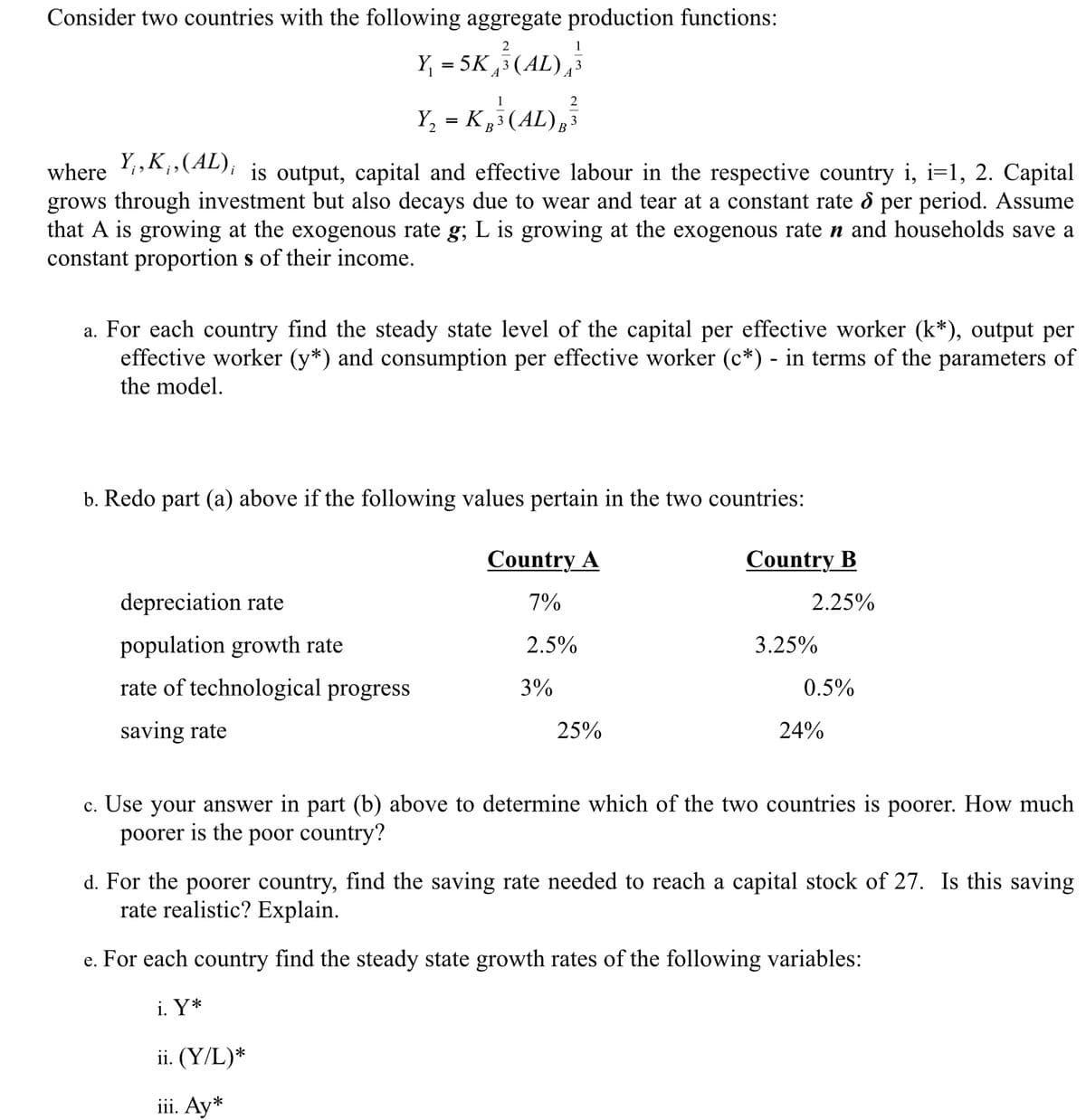Consider two countries with the following aggregate production functions: Y, = 5K,3(AL), Y, = K,³(AL), where Y,K,,(AL), grows through investment but also decays due to wear and tear at a constant rate d per period. Assume that A is growing at the exogenous rate g; L is growing at the exogenous rate n and households save a constant proportion s of their income. is output, capital and effective labour in the respective country i, i=1, 2. Capital a. For each country find the steady state level of the capital per effective worker (k*), output per effective worker (y*) and consumption per effective worker (c*) - in terms of the parameters of the model. b. Redo part (a) above if the following values pertain in the two countries: Country A Country B depreciation rate 7% 2.25% population growth rate 2.5% 3.25% rate of technological progress 3% 0.5% saving rate 25% 24% c. Use your answer in part (b) above to determine which of the two countries is poorer. How much poorer is the poor country?
Consider two countries with the following aggregate production functions: Y, = 5K,3(AL), Y, = K,³(AL), where Y,K,,(AL), grows through investment but also decays due to wear and tear at a constant rate d per period. Assume that A is growing at the exogenous rate g; L is growing at the exogenous rate n and households save a constant proportion s of their income. is output, capital and effective labour in the respective country i, i=1, 2. Capital a. For each country find the steady state level of the capital per effective worker (k*), output per effective worker (y*) and consumption per effective worker (c*) - in terms of the parameters of the model. b. Redo part (a) above if the following values pertain in the two countries: Country A Country B depreciation rate 7% 2.25% population growth rate 2.5% 3.25% rate of technological progress 3% 0.5% saving rate 25% 24% c. Use your answer in part (b) above to determine which of the two countries is poorer. How much poorer is the poor country?
Chapter1: Making Economics Decisions
Section: Chapter Questions
Problem 1QTC
Related questions
Question

Transcribed Image Text:Consider two countries with the following aggregate production functions:
2
1
Y, = SK,5(AL),
2
Y, = K3
В
where
Y;,K;,(AL); is output, capital and effective labour in the respective country i, i=1, 2. Capital
grows through investment but also decays due to wear and tear at a constant rate d per period. Assume
that A is growing at the exogenous rate g; L is growing at the exogenous rate n and households save a
constant proportion s of their income.
a. For each country find the steady state level of the capital per effective worker (k*), output per
effective worker (y*) and consumption per effective worker (c*) - in terms of the parameters of
the model.
b. Redo part (a) above if the following values pertain in the two countries:
Country A
Country B
depreciation rate
7%
2.25%
population growth rate
2.5%
3.25%
rate of technological progress
3%
0.5%
saving rate
25%
24%
c. Use your answer in part (b) above to determine which of the two countries is poorer. How much
poorer is the poor country?
d. For the poorer country, find the saving rate needed to reach a capital stock of 27. Is this saving
rate realistic? Explain.
e. For each country find the steady state growth rates of the following variables:
i. Y*
ii. (Y/L)*
iii. Ay*
Expert Solution
This question has been solved!
Explore an expertly crafted, step-by-step solution for a thorough understanding of key concepts.
This is a popular solution!
Trending now
This is a popular solution!
Step by step
Solved in 4 steps

Knowledge Booster
Learn more about
Need a deep-dive on the concept behind this application? Look no further. Learn more about this topic, economics and related others by exploring similar questions and additional content below.Recommended textbooks for you


Principles of Economics (12th Edition)
Economics
ISBN:
9780134078779
Author:
Karl E. Case, Ray C. Fair, Sharon E. Oster
Publisher:
PEARSON

Engineering Economy (17th Edition)
Economics
ISBN:
9780134870069
Author:
William G. Sullivan, Elin M. Wicks, C. Patrick Koelling
Publisher:
PEARSON


Principles of Economics (12th Edition)
Economics
ISBN:
9780134078779
Author:
Karl E. Case, Ray C. Fair, Sharon E. Oster
Publisher:
PEARSON

Engineering Economy (17th Edition)
Economics
ISBN:
9780134870069
Author:
William G. Sullivan, Elin M. Wicks, C. Patrick Koelling
Publisher:
PEARSON

Principles of Economics (MindTap Course List)
Economics
ISBN:
9781305585126
Author:
N. Gregory Mankiw
Publisher:
Cengage Learning

Managerial Economics: A Problem Solving Approach
Economics
ISBN:
9781337106665
Author:
Luke M. Froeb, Brian T. McCann, Michael R. Ward, Mike Shor
Publisher:
Cengage Learning

Managerial Economics & Business Strategy (Mcgraw-…
Economics
ISBN:
9781259290619
Author:
Michael Baye, Jeff Prince
Publisher:
McGraw-Hill Education